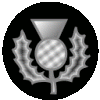The Infantry of the British Army comprises 49 infantry battalions, from 19 regiments. Of these, 33 battalions are part of the Regular army and the remaining 16 a part of the Army Reserve. The British Army's Infantry takes on a variety of roles, including armoured, mechanised, air assault and light.

The 9th (Scottish) Division, was an infantry division of the British Army during the First World War, one of the Kitchener's Army divisions raised from volunteers by Lord Kitchener to serve on the Western Front during the First World War.
The 27th Division was an infantry division of the British Army raised during the Great War, formed in late 1914 by combining various Regular Army units that had been acting as garrisons about the British Empire. The division spent most of 1915 on the Western Front in France before moving to Salonika where it remained with the British Salonika Army for the duration of the war. In 1916 its commander Hurdis Ravenshaw was captured by an Austrian submarine whilst sailing to England. In 1918 in Salonika the division took part in the Battle of Doiran. It carried out occupation duties in the Caucasus in the post-war before being withdrawn from the region in 1919.

The Argyll and Sutherland Highlanders (Princess Louise's) is a light infantry company (designated as Balaklava Company, 5th Battalion, Royal Regiment of Scotland) and was a line infantry regiment of the British Army that existed from 1881 until amalgamation into the Royal Regiment of Scotland on 28 March 2006.

The 33rd Division was an infantry division of the British Army that was raised in 1914, during the First World War. The division was raised from volunteers for Lord Kitchener's New Armies, that was originally made up of infantry battalions raised by public subscription or private patronage. The division was taken over by the War Office in September 1915. It served in France and Belgium in the trenches of the Western Front for the duration of the war. The division's insignia was the "double-three" from a set of dominoes.

The 52nd Lowland Volunteers is a battalion in the British Army's Army Reserve or reserve force in the Scottish Lowlands, forming the 6th Battalion of the Royal Regiment of Scotland, also known as 6 SCOTS. Due to its erstwhile association with the 1st Regiment of Foot, it is the senior Reserve line infantry battalion in the British Army. It is one of two Reserve battalions in the Royal Regiment of Scotland, along with 51st Highland, a similar unit located in the Scottish Highlands.

The Scottish Division was a British Army Infantry command, training and administrative apparatus designated for all Scottish line infantry units. It merged with the Prince of Wales' Division, to form the Scottish, Welsh and Irish Division in 2017.

The 9th Armoured Division was an armoured division of the British Army, raised during the Second World War. It never saw active service during the war as a complete division.

The Royal Regiment of Scotland is the senior and only Scottish line infantry regiment of the British Army Infantry. It consists of three regular and two reserve battalions, plus an incremental company, each formerly an individual regiment. However, three regular battalions maintain their former regimental pipes and drums to carry on the traditions of their antecedent regiments.

The 27th Infantry Brigade was an infantry brigade of the British Army that saw service in the First World War, the Second World War, and the Korean War. In Korea, the brigade was known as 27th British Commonwealth Brigade due to the addition of Canadian, Australian, New Zealand and Indian units.
The 46th Infantry Brigade was an infantry brigade of the British Army that saw active service in both the First and the Second World Wars with the 15th (Scottish) Infantry Division.
In September 1939, the British Army was in process of expanding their anti-aircraft and mobile assets. Among these new changes was the formation of Anti-Aircraft Command which was formed on 1 April 1939, and the 1st Armoured Division formed in 1937. The list below will include the British Army units, colonial units, and those units which were in the process of formation.
The 157th Brigade was an infantry brigade of the British Army. The brigade fought in both the First and the Second World Wars, assigned to 52nd (Lowland) Infantry Division.
The 45th Infantry Brigade was an infantry brigade of the British Army that saw active service in both the First and the Second World Wars with 15th (Scottish) Infantry Division.
The 207th Independent Infantry Brigade was a Home Defence formation of the British Army during the Second World War.
221st Mixed Brigade was a Scottish Home Service formation of the British Army that served under various titles throughout World War I.
The Clyde Brigade was a Scottish infantry formation of Britain's Volunteer Force from 1888 to 1902.
The Glasgow Brigade was an infantry formation of Britain's Volunteer Force from 1890 to 1902. It was the forerunner of two formations of the Territorial Force that saw service in both World Wars.







